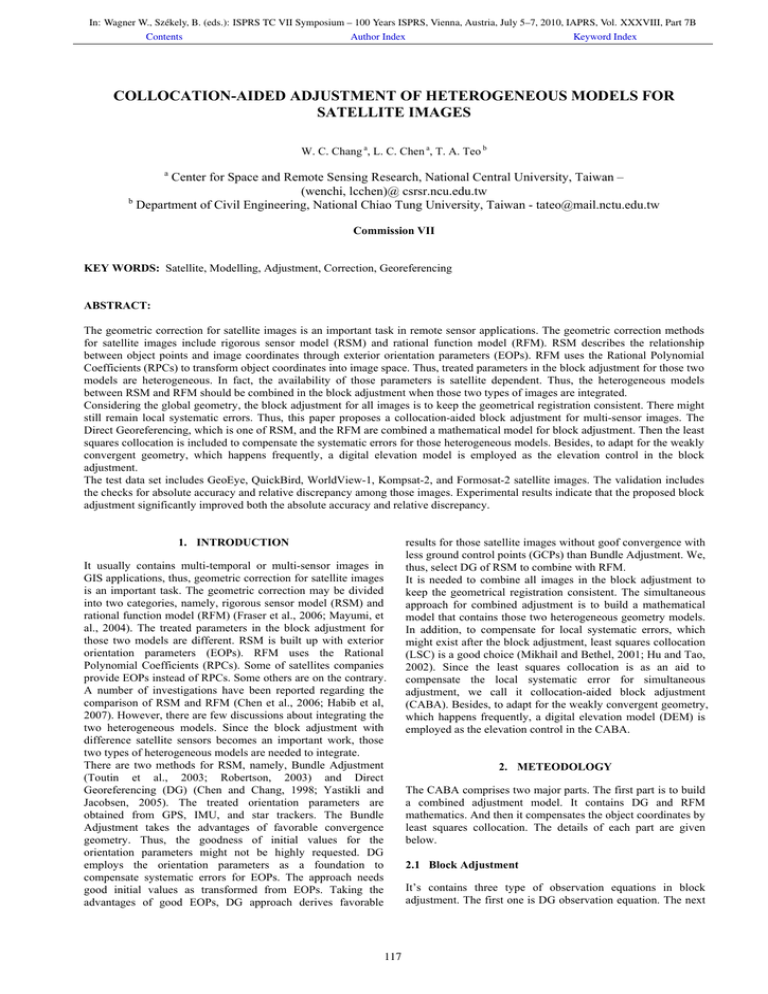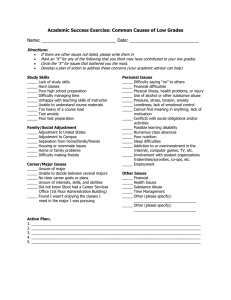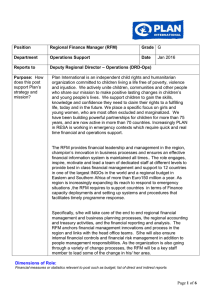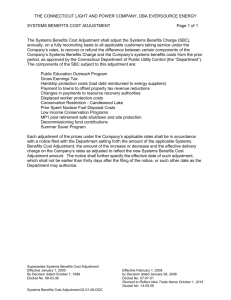COLLOCATION-AIDED ADJUSTMENT OF HETEROGENEOUS MODELS FOR SATELLITE IMAGES
advertisement

In: Wagner W., Székely, B. (eds.): ISPRS TC VII Symposium – 100 Years ISPRS, Vienna, Austria, July 5–7, 2010, IAPRS, Vol. XXXVIII, Part 7B Contents Author Index Keyword Index COLLOCATION-AIDED ADJUSTMENT OF HETEROGENEOUS MODELS FOR SATELLITE IMAGES W. C. Chang a, L. C. Chen a, T. A. Teo b a Center for Space and Remote Sensing Research, National Central University, Taiwan – (wenchi, lcchen)@ csrsr.ncu.edu.tw b Department of Civil Engineering, National Chiao Tung University, Taiwan - tateo@mail.nctu.edu.tw Commission VII KEY WORDS: Satellite, Modelling, Adjustment, Correction, Georeferencing ABSTRACT: The geometric correction for satellite images is an important task in remote sensor applications. The geometric correction methods for satellite images include rigorous sensor model (RSM) and rational function model (RFM). RSM describes the relationship between object points and image coordinates through exterior orientation parameters (EOPs). RFM uses the Rational Polynomial Coefficients (RPCs) to transform object coordinates into image space. Thus, treated parameters in the block adjustment for those two models are heterogeneous. In fact, the availability of those parameters is satellite dependent. Thus, the heterogeneous models between RSM and RFM should be combined in the block adjustment when those two types of images are integrated. Considering the global geometry, the block adjustment for all images is to keep the geometrical registration consistent. There might still remain local systematic errors. Thus, this paper proposes a collocation-aided block adjustment for multi-sensor images. The Direct Georeferencing, which is one of RSM, and the RFM are combined a mathematical model for block adjustment. Then the least squares collocation is included to compensate the systematic errors for those heterogeneous models. Besides, to adapt for the weakly convergent geometry, which happens frequently, a digital elevation model is employed as the elevation control in the block adjustment. The test data set includes GeoEye, QuickBird, WorldView-1, Kompsat-2, and Formosat-2 satellite images. The validation includes the checks for absolute accuracy and relative discrepancy among those images. Experimental results indicate that the proposed block adjustment significantly improved both the absolute accuracy and relative discrepancy. 1. INTRODUCTION It usually contains multi-temporal or multi-sensor images in GIS applications, thus, geometric correction for satellite images is an important task. The geometric correction may be divided into two categories, namely, rigorous sensor model (RSM) and rational function model (RFM) (Fraser et al., 2006; Mayumi, et al., 2004). The treated parameters in the block adjustment for those two models are different. RSM is built up with exterior orientation parameters (EOPs). RFM uses the Rational Polynomial Coefficients (RPCs). Some of satellites companies provide EOPs instead of RPCs. Some others are on the contrary. A number of investigations have been reported regarding the comparison of RSM and RFM (Chen et al., 2006; Habib et al, 2007). However, there are few discussions about integrating the two heterogeneous models. Since the block adjustment with difference satellite sensors becomes an important work, those two types of heterogeneous models are needed to integrate. There are two methods for RSM, namely, Bundle Adjustment (Toutin et al., 2003; Robertson, 2003) and Direct Georeferencing (DG) (Chen and Chang, 1998; Yastikli and Jacobsen, 2005). The treated orientation parameters are obtained from GPS, IMU, and star trackers. The Bundle Adjustment takes the advantages of favorable convergence geometry. Thus, the goodness of initial values for the orientation parameters might not be highly requested. DG employs the orientation parameters as a foundation to compensate systematic errors for EOPs. The approach needs good initial values as transformed from EOPs. Taking the advantages of good EOPs, DG approach derives favorable 117 results for those satellite images without goof convergence with less ground control points (GCPs) than Bundle Adjustment. We, thus, select DG of RSM to combine with RFM. It is needed to combine all images in the block adjustment to keep the geometrical registration consistent. The simultaneous approach for combined adjustment is to build a mathematical model that contains those two heterogeneous geometry models. In addition, to compensate for local systematic errors, which might exist after the block adjustment, least squares collocation (LSC) is a good choice (Mikhail and Bethel, 2001; Hu and Tao, 2002). Since the least squares collocation is as an aid to compensate the local systematic error for simultaneous adjustment, we call it collocation-aided block adjustment (CABA). Besides, to adapt for the weakly convergent geometry, which happens frequently, a digital elevation model (DEM) is employed as the elevation control in the CABA. 2. METEODOLOGY The CABA comprises two major parts. The first part is to build a combined adjustment model. It contains DG and RFM mathematics. And then it compensates the object coordinates by least squares collocation. The details of each part are given below. 2.1 Block Adjustment It’s contains three type of observation equations in block adjustment. The first one is DG observation equation. The next In: Wagner W., Székely, B. (eds.): ISPRS TC VII Symposium – 100 Years ISPRS, Vienna, Austria, July 5–7, 2010, IAPRS, Vol. XXXVIII, Part 7B Contents Author Index Keyword Index one is about RFM. Ground Coordinates observation equation is the latest. k k k vk 1 2.1.1 Direct Georeferencing: There are orbital parameters correction and object coordinates correction, which is shown in equation (1). It is employed for compensating the systematic errors of the exterior orientation. vxi x0 a0 a1 t Xi z0 c0 c1 t Zi uXi uZi vyi y0 b0 b1 t Xi z0 c0 c1 t Zi uYi uZi where (1) (4) k is the x, y, z axis k is the correct value of the interpolated point σk is the row covariance matrix for the interpolated point with respect to the reference points Σk is the covariance matrix for the reference points vk indicates the residual vectors 3. EXPERIMENTS where vxi, vyi are the residual values Xi, Yi, Zi are the ground coordinates x0, y0, z0 are the satellite positions u Xi , uYi , uZi are the satellite light-of-sight vectors t is the time a0 ~ c1 are the orbital correction parameters The test data set includes GeoEye-1, QuickBird, WorldView-1, Kompsat-2, and two Formosat-2 satellite images. Figure 1 shows the six images. The GSDs are sub-meter for GeoEye-1, QuickBird, and WorldView-1 images. Kompsat-2 image’s GSD is about 1 m. And the GSDs for Formosat-2 images are more than 2m. The GCPs and independent check points (ICPs) were obtained from the ground control point database of the Ministry of the Interior, Taiwan, by manual measurements. The measurement accuracy is estimated to be better than 0.5 m. The TPs and independent check tie points (ICTPs) are acquired by manual measurements. The resolution of DEM is 5 m. The other related information is shown in Table 1 and Table 2. 2.1.2 Rational Function Model: We use an affine transformation to compensate the systematic bias of RPCs. For this reason, affine transformation and object coordinates correction are included in the RFM observation equation, formulated as equation (2). S A0 A1 S RFM A2 LRFM L B0 B1 S RFM B2 LRFM where (2) S, L are the image coordinates SRFM, LRFM are the image coordinates decided by RFM A0~B2 are the affine coefficients 2.1.3 Ground Coordinates observation equations: It is used to distinguish GCPs ground coordinates and tie points (TPs) ground coordinates. The equation is shown in (3). (A) WorldView-1 ©DigitalGlobe, 2007 (B) QuickBird ©DigitalGlobe, 2005 (C) Geoeye-1 ©Geoeye, 2009 (D) Kompsat-2 ©KARI, 2007 (E) Formosat-2_1 ©NSPO, 2006 (F) Formosat-2_2 ©NSPO, 2007 v X i dX i X i0 X i00 vYi dYi Yi 0 Yi 00 vZ i dZ i Z Z 0 i where (3) 00 i vXi, vYi, vZi are the residual values X i0 , Yi 0 , Z i0 are the approximation values X i00 , Yi 00 , Z i00 are the measured values 2.2 Least Squares Collocation After block adjustment, the all object coordinates can be computed. In order to improve the geometric consistency between the image strips, least squares collocation is employed for compensating the local systematic errors of object coordinates. We assume that the X, Y, Z-axis are independent. Thus, we use three one-dimensional least squares collocation functions, which is shown in equation (4), to adjust the object coordinates. Figure 1. Test Images 118 In: Wagner W., Székely, B. (eds.): ISPRS TC VII Symposium – 100 Years ISPRS, Vienna, Austria, July 5–7, 2010, IAPRS, Vol. XXXVIII, Part 7B Contents Descriptions Geometric Model Level Date GSD (m) Image Size No. of GCPs/ICPs No. of TPs/ICTPs Author Index WorldView-1 QuickBird Geoeye-1 RFM RSM RFM Basic 2007/11/25 0.67 35170 x 23708 Basic 2005/12/23 0.63 27552 x 29320 Standard 2009/9/20 0.5 19872 x 16000 9/31 9/20 5/6 16/24 16/24 16/21 Keyword Index WV-E WV-N QB-E QB-N GE-E GE-N KP-E KP-N FS_1-E FS_1-N FS_2-E FS_2-N Table 1. Information Related to Test Data single 0.87 0.64 0.50 0.62 0.56 0.43 0.94 1.83 6.15 2.36 6.92 2.65 CABA 0.87 0.55 0.47 0.50 0.51 0.45 1.01 2.03 2.65 1.28 3.67 2.15 Improvement 0.00 0.09 0.04 0.11 0.04 -0.03 -0.07 -0.20 3.50 1.07 3.25 0.49 Unit: m Descriptions Geometric Model Level Date GSD (m) Image Size No. of GCPs/ICPs No. of TPs/ICTPs Kompsat-2 Formosat-2_1 Formosat-2_2 RFM RSM RSM 1A 2007/10/21 1.03 15000 x 15500 1A 2006/8/19 2.01 12000 x 12000 1A 2007/1/30 2.45 12000 x 12000 5/12 9/18 9/22 11/20 6/17 6/14 Table 3. Absolute Accuracy Evaluation 3.2 Geometrical Consistency The results for geometrical consistency between images are shown as Table 4. The CABA results for the WV, QB and GE images are approximately 0.5 m. The relative discrepancy can be improved from about 3 m to less than 2 m for the KP image. The improvement is significant for those two FS images. The relative discrepancy for the former is about 9 m, with single image adjustment. This decreases to approximately 3 m using CABA. The second one is the same. The errors obtained are from 7 m to about 3 m. Table 2. Information Related to Test Data The validation include the absolute accuracy and the geometrical consistency between images. We use ICPs and ICTPs with the proposed model to evaluate the absolute accuracy and the geometrical consistency between images, respectively. The bias between the determined object coordinates and the true coordinates is calculated to find the root mean squared error (RMSE) for the ICPs. The ICTPs’ RMSE is obtained from the relative discrepancy for each image. To reveal the contributions of CABA, the results of the single image adjustment without collocation, herein named single, are also given. The Formosat-2, WorldView-1, Quickbird, Geoeye1 and Kompsat-2 satellites images are labelled FS, WV, QB, GE and KP, respectively, in those results. WV-E WV-N QB-E QB-N GE-E GE-N KP-E KP-N FS_1-E FS_1-N FS_2-E FS_2-N 3.1 Absolute Accuracy The results of absolute accuracy are shown as Table 3. According to Table 3, the absolute accuracy for WV is about 0.9 m and better than 0.5 m for the QB and GE images. The absolute accuracy of KP is approximately 2 m. There is a small difference between the two methods for the higher resolution images. For the two FS images, the accuracy can improve to about 3.5 m when CABA is employed. single 0.56 0.80 0.42 0.62 0.49 0.64 1.14 2.82 9.21 6.52 6.84 2.34 CABA 0.57 0.47 0.41 0.57 0.38 0.51 1.17 1.83 2.65 3.15 3.22 2.53 Improvement -0.01 0.33 0.01 0.05 0.12 0.13 -0.02 1.00 6.56 3.37 3.62 -0.19 Unit: m Table 4. Geometrical Consistency between Images 4. CONCLUSIONS This paper combines DG and RFM for multi-sensor block adjustment. Two heterogeneous models with DEM as elevation control are integrated. The experimental results indicate that the proposed method can significantly improve the geometric accuracy as well as reduce discrepancies when multi-resolution images are used. Tests indicate that the proposed method should be feasible for real applications. 119 In: Wagner W., Székely, B. (eds.): ISPRS TC VII Symposium – 100 Years ISPRS, Vienna, Austria, July 5–7, 2010, IAPRS, Vol. XXXVIII, Part 7B Contents Author Index ACKONWLEDGMENTS This investigation is partially supported by the National Land Surveying and Mapping Center, Ministry of the Interior, Taiwan. REFERENCES Chen, L.C., and L.Y. Chang, 1998. Three Dimensional Positioning Using SPOT Stereostrips with Sparse Control, Journal of Surveying Engineering, 124(2):63-72. Chen, L. C., Teo, T. A., and Liu, J. L., 2006. The geometrical comparisons of RSM and RFM for FORMOSAT-2 Satellite Images. Photogrammetric Engineering and Remote Sensing. 72(5), pp.573-579. Fraser, C.S., G. Dial, and J. Grodecki, 2006. Sensor Orientation via RPCs, ISPRS Journal of Photogrammetry & Remote Sensing, 60(3), pp.182-194. Habib, A., Shin, S.W., Kim, K., Kim, C., Bang, K.I., Kim, E.M., and Lee, D.C., 2007, Comprehensive Analysis of Sensor Modeling Alternatives for High Resolution Imaging Satellites. Photogrammetric Engineering & Remote Sensing, 73(11), pp.1241-1251. Hu, Y. and C.V. Tao, 2002. Updating solution of the rational function model using additional control information. Photogrammetric Engineering and Remote Sensing. 68(7), pp.715-723. Mayumi, N., C.S. Fraser, N. Takayuki, S. Takahiro, and O. Shoichi, 2004. Accuracy assessment of QuickBird stereo imagery, The Photogrammetric Record, 19(106), pp.128-137. Mikhail, E.M. and J.S. Bethel, 2001. Introduction to modern photogrammetry. John wiley and Sons, New York, pp.446-454. Robertson, B.C., 2003. Rigorous geometric modeling and correction of QuickBird imagery. International Geoscience and Remote Sensing Symposium, 21-25 July, Toulouse, France, on CD-ROM. Toutin, T., 2003. Block Bundle Adjustment of IKONOS InTrack Image, International Journal of Remote Sensing, 24(4), pp.851-857. Yastikli, N., and K. Jacobsen, 2005. Influence of system calibration on direct sensor orientation. Photogrammetric Engineering and Remote Sensing, 71(5), pp.629-633. 120 Keyword Index





